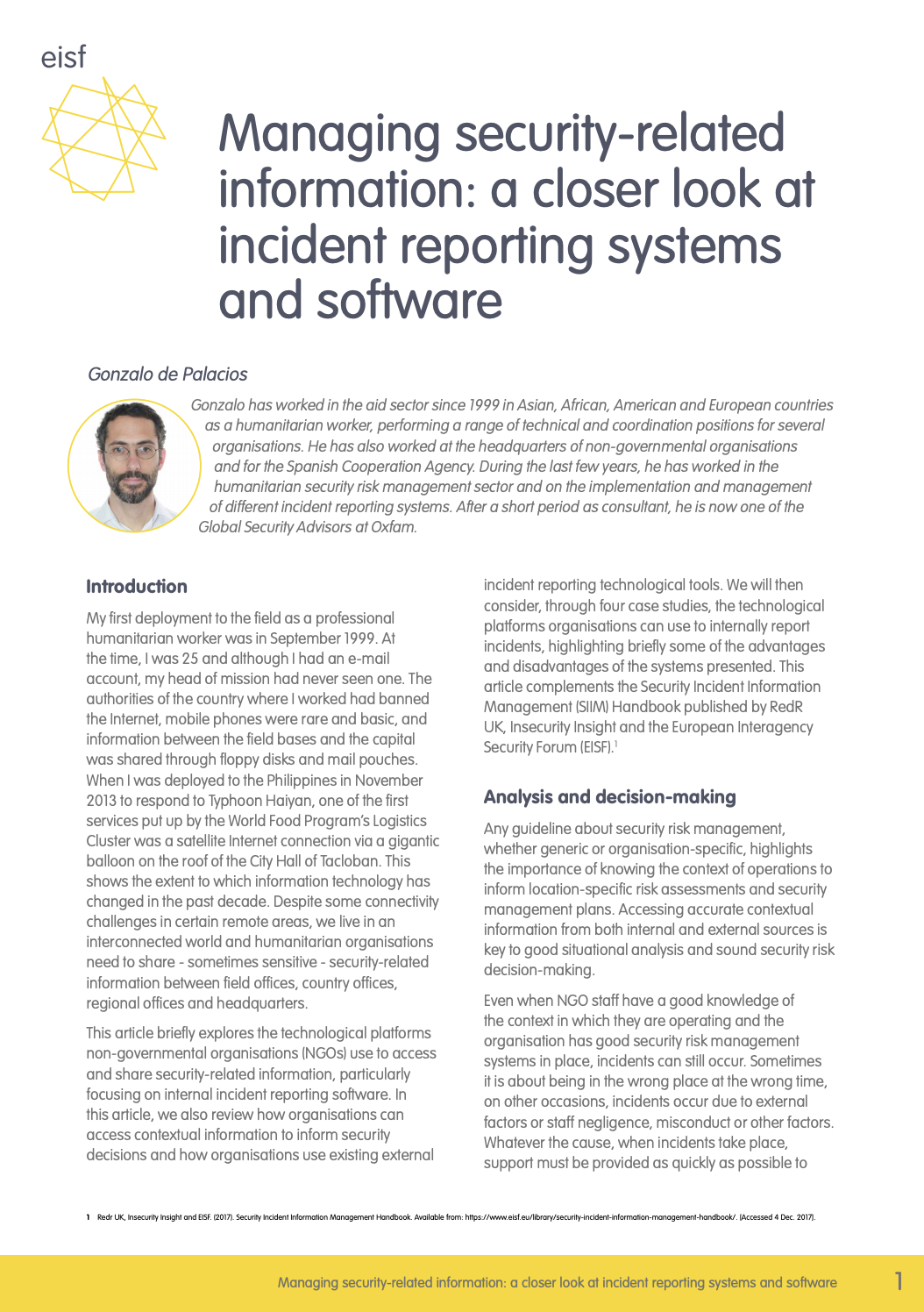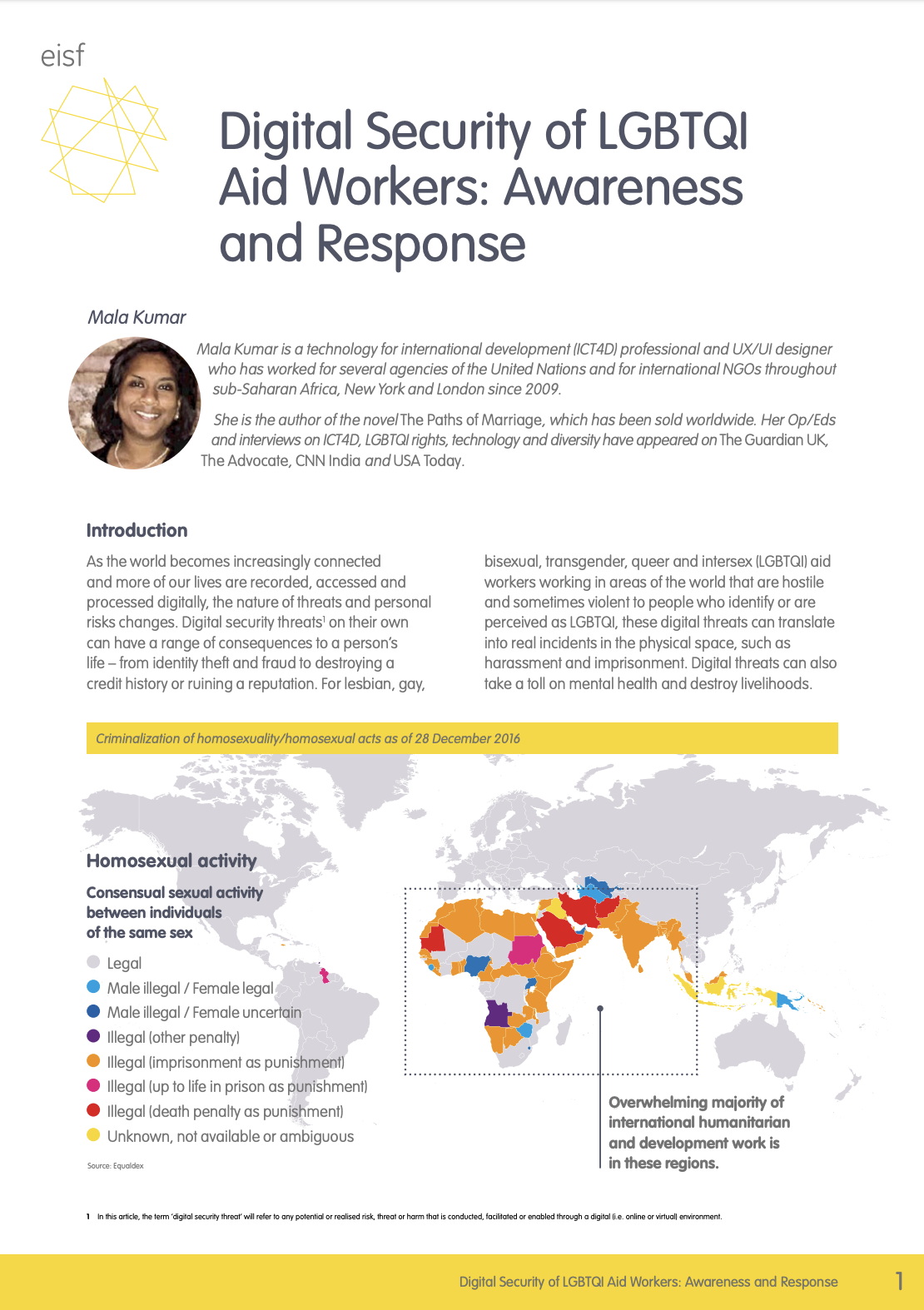Resources
Forward and Introduction to Communications Technology and Humanitarian Delivery
In this foreword by Hugo Slim and introduction by Raquel Vazquez and Imogen Wall, the authors introduce the Communications Technology and Humanitarian Delivery project.

Managing security-related information: a closer look at incident reporting systems and software
This article briefly explores the technological platforms NGOs use to access and share security-related information, particularly focusing on internal incident reporting software.

Digital Security of LGBTQI Aid Workers: Awareness and Response
This article discusses the digital risks that LGBTQI aid workers may face while working in areas that are hostile to people who identify or are perceived as LGBTQI, and ways in which aid workers and non-governmental organisations can prepare and respond to these risks.
Applying serious gaming to humanitarian security: A framework for mixed-reality training
This article explores how mobile devices can play an important role in crisis situations involving role-playing. Although they don’t match the immersive feeling a participant gets when entering a real-world simulation, mobile devices are well suited to orchestrate a flow of events through a ‘mixed-reality’ environment, allowing the learners to move between virtual tasks assigned on the device and the physical environment.
What is ‘humanitarian communication’? Towards standard definitions and protections for the humanitarian use of ICTs
The increasing use of ICTs by responding organisations and affected populations has changed how information is communicated and received during crises. It may even be changing how some crises occur and unfold. Yet, despite this transformative impact, there is no accepted definition of what constitutes ‘humanitarian communication’, nor what defines the ‘humanitarian use of ICTs’.
Measures for Mitigating Cyber-Security Risks
In this article, Rory Byrne explores measures NGOs can put in place to mitigate cyber-security risks.
Applicability of Open Source Systems (Ushahidi) for Security Management, Incident and Crisis Mapping: Acción contra el Hambre (ACF-Spain) Case Study
In this article, Gonzalo de Palacios analyses the Ushahidi system and its applicability to security risk management, particularly incident and crisis mapping.
SMS Technology and Bulk SMS Delivery Systems: Their Role in Security Management for the Humanitarian Community
In this article, Athalie Mayo explores the role of SMS technology and bulk SMS delivery systems in humanitarian security risk management.
Mobile Money Systems for Humanitarian Delivery: World Vision Cash Transfer Project in Gihembe Refugee Camp, Rwanda
This article draws learnings from a World Vision cash transfer project in Rwanda to understand the use of mobile money systems for humanitarian delivery.
A Principled Approach to Data Management: Lessons Learned from Medair’s Experience in Lebanon Using Last Mile Mobile Solutions
In this article, Joel Kaiser and Rob Fielding describe the lessons Medair learned from its experience of using last mile mobile solutions in Lebanon.
Whispering when Everyone is Listening: Low-Tech Communications Technology Implementations in High-Risk Contexts
In this article, Keith Porcaro and Laura Walker Hudson examine relevant case studies around the use of communications technology in high-risk contexts and suggest useful programme practices for high-risk implementations, from community outreach and crafting message content to implementation practices that minimise risk to staff, community members, and user data.
Monitoring Online Dangerous Speech in Kenya: Insights from the Umati Project
This article examines insights from the Umati project in Kenya for understanding how technology can be used to monitor dangerous speech on different online platforms which has the potential to catalyse collective violence.
Conjuring Zones of Insecurity: Post-Conflict Election Campaigning by Text Message in Aceh, Indonesia
In this article, Jesse Hession Grayman and Bobby Anderson describe the use of text messaging during the post-conflict election campaigning in Aceh, Indonesia.
The Dichotomy of Technology in Conflict: Beauty and the Beast
In this article, Anahi Ayala explores the link between technology, violence and conflict.
Trends in Intelligence Gathering by Governments
In this article, Rory Byrne aims to give the non-technical reader an introduction to trends in digital intelligence gathering by governments.
Cyber-Warfare and Humanitarian Space
In this article, Daniel Gilman explores the impact that cyber-warfare can have on humanitarian space.